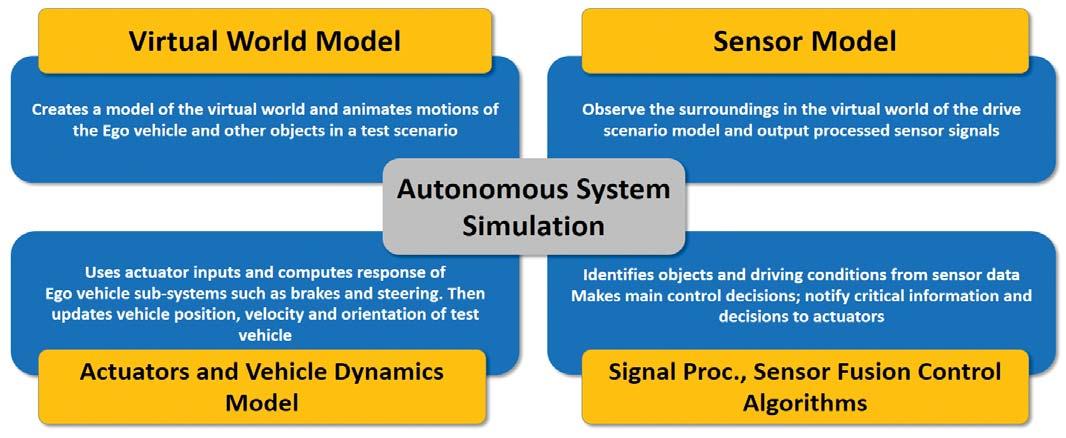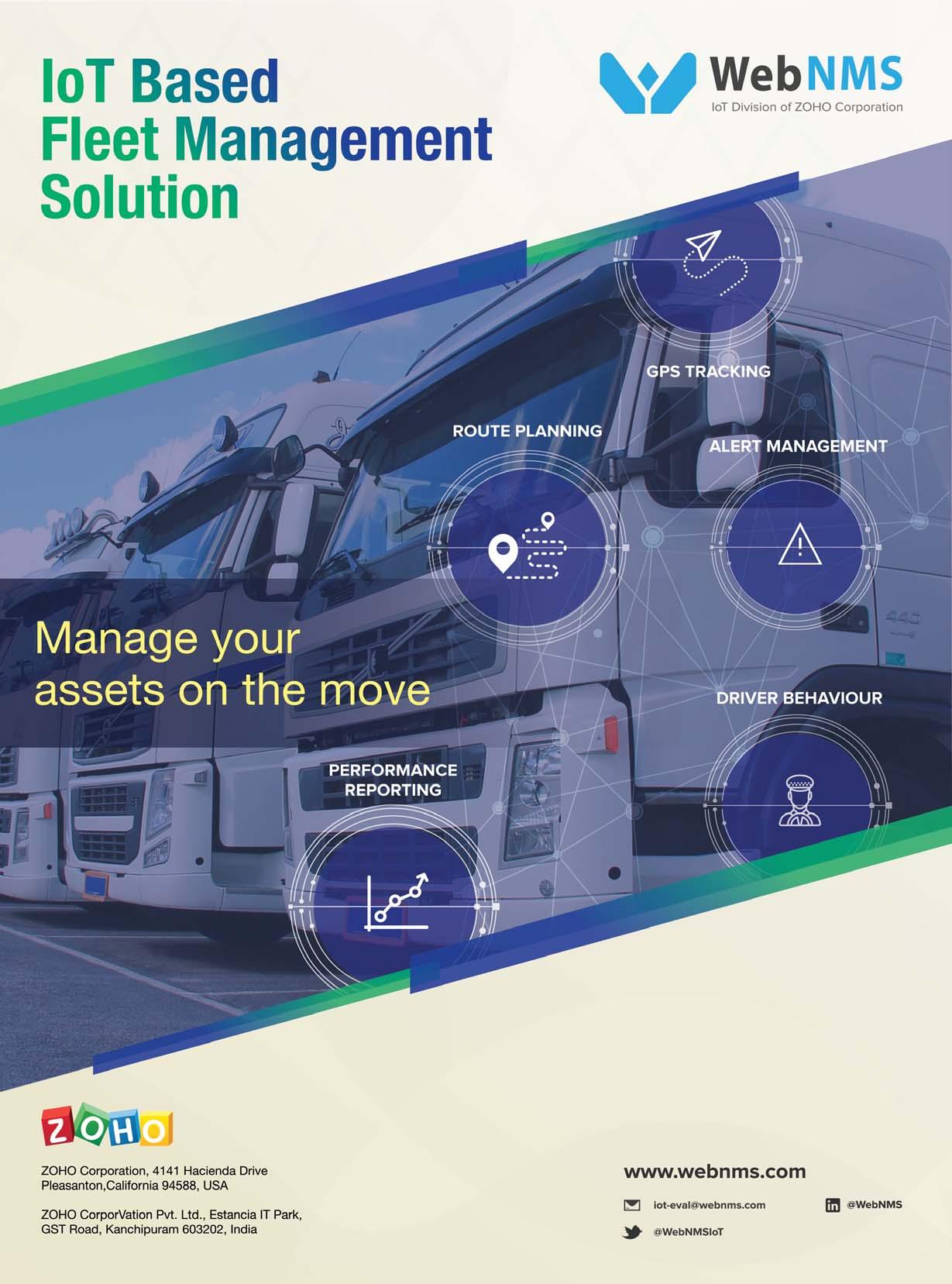
10 minute read
on in Development of Reliable and Safe Autonomous VehicleThe Role of SimulaƟ
The Role of Simulation in Development of Reliable and Safe Autonomous Vehicle
Ashok Khondge
Advertisement
Principal Engineer, ANSYS Customer Excellence, ANSYS, Inc.
Ashok Khondge serves as automoƟ ve CAE applicaƟ on specialist for Asia region and part of ANSYS Customer Excellence team. Over past 15 years he has held product, applicaƟ ons and leadership roles providing CAE soluƟ ons to AutomoƟ ve industry.
Leading automakers across the world are giving high priority to development of autonomous vehicles. It is a formidable technological challenge. Studies show that billions of miles of road testing will be necessary to ensure safety and reliability of autonomous vehicles, yet time-tomarket is short with competition heating up. This seemingly difficult task can only be accomplished using simulation with precision, speed and within available resources.
Background and Challenges
Connected and smart vehicles, Ride sharing, Electrifi caƟ on and Autonomous vehicles are disrupƟ ng transportaƟ on industry today. The global compeƟƟ on to develop such technologies is heaƟ ng up. New business models will evolve taking advantage of such technology innovaƟ ons. The fi rst company to have the upper hand will win and sustain. The autonomous vehicle revoluƟ on will have a major impact on the vehicle manufacturing and will change the society forever. But creaƟ ng autonomous vehicle is a formidable technological challenge. The autonomous vehicle can be described as a super computer crunching tens of terabytes of data during a few hours of driving. Developing autonomous vehicle technology requires ambiƟ ous new development in various technologies such as sensing, machine learning and arƟfi cial intelligence. The reliable development of machine learning based vision and percepƟ on models that imitate human driver under all possible driving condiƟ on is a major problem. An autonomous vehicle’s computer needs a 360-degree surround view. It must recognize other vehicles, road signs, pedestrians, markings, trees, buildings, traffi c lights, and several other things under all possible driving scenarios and weather condiƟ ons such as in the darkness of night or while fogging, in rain and in snow etc. This is a diffi cult problem to solve using rule based computer algorithms. Autonomous vehicle engineers are using machine learning based neural network methods that can be trained using data rather than programmed. Autonomous vehicle engineers train such computer models by feeding them with enough test data to suffi ciently react to mulƟ ple scenarios. However, the problem is, it is not easy or safe to replicate many scenarios in the real-world environments. A report by RAND [1] indicate that autonomous vehicles would have to be driven hundreds of millions of miles or someƟ mes billions of miles to demonstrate acceptable reliability. Under very aggressive tesƟ ng assumpƟ ons, it would take tens of years or may be hundreds of years to drive these many miles. This is an impossible proposiƟ on to develop reliable and safe autonomous vehicles.
Fast-tracking Reliable and Safe Autonomy
To fast track the development of autonomous vehicles, auto OEMs may start rolling out autonomous vehicles suitable for constrained environment. OEMs may collaborate with likes of Uber and Ola, operaƟ ng within certain city limit with constrained border lowering the technological barrier. However, this may sƟ ll take several years to develop autonomous vehicles given that machine learning based neural network algorithms need a lot of data to make them reliable, and safe. The other opƟ on is to build machine learning models that will be able to train with liƩ le data. However, such technology development is in early phase of research. Finally, it is the simulaƟ on, if build properly can help autonomous vehicle engineers to gather enough training data and test their algorithms in quick Ɵ me. SimulaƟ on has been used in automoƟ ve industry for several decades with proven record of acceleraƟ ng technology development. With simulaƟ on, thousands of virtual tests can be performed on virtual prototypes using computers, enabling acceleraƟ on in technology development within a fracƟ on of budget and Ɵ me required for physical tesƟ ng. SimulaƟ on provides three broad benefi ts namely – Faster Ɵ me-to-market, Reduced cost, and Enhanced product quality.
Autonomous vehicle system is essenƟ ally a control loop, comprising of four important elements – physical world, sensors, controllers and actuators (Figure 1). An autonomous drive control soŌ ware is embedded on controller with ability to train itself while performing virtual tests such as Model in loop (MiL), SoŌ ware in Loop (SiL), and Hardware in Loop (HiL). To replicate this autonomous driving system

Figure-1 Essential elements of autonomous system control
Figure-2 Autonomous driving system simulation loop

loop virtually – for instance, a scenario where a car approaches an intersecƟ on, looks for crossing traffi c, waits for crossing traffi c to clear, fi nds a safe moment and crosses the intersecƟ on – requires a model based system simulaƟ on (Figure 2).
The important building blocks of model based system simulaƟ on loop are: • Building virtual world with variety of driving scenarios including traffi c, weather, road, and environment etc. • Modelling mulƟ ple sensors such as
RADAR, LiDAR, Ultrasonic Sensors,
Camera etc. • Modelling sensor data processing and fusion, enabling detecƟ on of objects and recogniƟ on of driving condiƟ on based on simulated and processed sensor data. Developing control algorithm and human machine interface (HMI) with ability to take important driving decisions and display the informaƟ on. • Modelling vehicle actuaƟ on, and vehicle movement. The model based system simulaƟ on loop consists for following steps and it repeats unƟ l the driving scenario is completed.
The Virtual World
The vehicle with autonomous system is referred as Ego vehicle. It moves in this virtual world. The fi rst step in building system model is to construct the virtual world using libraries of roads, buildings, pedestrians, and other vehicles (Figure 3). Also, such world can be a replica of real city and can be constructed by using 3D
Figure-3 Virtual world model representing Ego Vehicle and its surroundings (image courtesy ANSYS, Inc., www.ansys.com )

map data of city.
Sensor Modelling & Performance
Typical sensor suite mounted on Ego Vehicle includes RADARs, LiDAR, Ultrasonic Sensors, and Cameras. This suite of sensors observes the virtual world surrounding the Ego Vehicle and generate simulated sensor signals. For simulaƟ ng cameras, building photorealisƟ c virtual environment is very important. It enables acquisiƟ on of good quality simulated signals. LiDAR is another important sensor that constantly generates simulated 3D map of vehicle surroundings and provide high resoluƟ on wide fi eld of view. SimulaƟ on of LiDAR involves 3D ray tracing, and processing point cloud obtained from the refl ected rays. High fi delity 3D electromagneƟ cs simulaƟ ons are used to predict performance of RADARs and V2X antennas e.g. an automoƟ ve RADAR antenna paƩ ern when it is installed on car facia (Figure 4). The high-fi delity 3D modelling is an order of magnitude, slow when compared with real Ɵ me simulaƟ on. To alleviate this problem surrogate modelling techniques (a.k.a. Reduced Order Models or ROMS) are used to create a real Ɵ me sƟ ll accurate sensor models that can be integrated in the virtual world.
Figure-4 Automotive RADAR antenna pattern when it is installed on car facia (image courtesy ANSYS, Inc., www.ansys.com)

The simulated signals received from various sensors are passed to signal processing, sensor data fusion and control algorithms. These algorithms make decision about braking, acceleraƟ ng or changing direcƟ on of Ego Vehicle. These control algorithms based on machine learning methods can be uƟ lized for training as well as conducƟ ng virtual tesƟ ng. Developing and tesƟ ng signal processing funcƟ ons, sensor fusion algorithms, object recogniƟ on funcƟ ons, control algorithms, and human machine interface (HMI) soŌ ware, with model-based soŌ ware development techniques makes the soŌ ware robust, less error-prone, and safe. AutomoƟ ve manufacturers and suppliers increasingly follow the ISO 26262 standard for engineering acƟ ve and passive safety systems in vehicles. Since autonomous vehicle systems are inherently safety criƟ cal, the ISO 26262 standard is essenƟ al in their development.
Siemens, Munich Security Conference (MSC), Airbus, Allianz, Daimler Group, IBM, SGS, Deutsche Telekom and NXP have signed the Charter of Trust on February 16, 2018 for binding rules and standards to build trust in cybersecurity and further advance digitalizaƟ on. The iniƟ aƟ ve was welcomed by Canadian foreign minister and G7 representaƟ ve ChrysƟ a Freeland as well as witnessed by Elbieta Biekowska, the EU Commissioner for Internal Market, Industry, Entrepreneurship and Small and Medium-sized Enterprises. The Charter delineates acƟ on areas in cybersecurity where governments and businesses must both become acƟ ve some of those are: • Responsibility for cybersecurity to be assumed at the highest levels of government and business. IntroducƟ on of a dedicated ministry in governments and a chief informaƟ on security offi cer at companies. • Companies to establish mandatory, independent third-party cerƟfi caƟ on for criƟ cal infrastructure and soluƟ ons – above all, where dangerous situaƟ ons can arise, such as with autonomous vehicles or the robots of tomorrow, which will interact directly with humans during producƟ on processes. • In the future, security and data the virtual world. Model based system simulaƟ ons are highly valuable for developing training data set. SimulaƟ on allows engineers to construct staƟ sƟ cally hazardous scenarios that are important for an autonomous vehicle computer or controller to be able to recognize. Such scenario may not come during hundreds of hours of training on real roads. AddiƟ onally, using simulaƟ on, engineers can conduct system failure mode and eff ect analysis – e.g. eff ect of failure of one of the sensor or failure to pass the signal from controller to actuator etc.
AŌ er processing sensors data, controller passes simulated commands to actuators such as brakes and steering, and virtual powertrain which control the Ego Vehicle’s movement. Vehicle dynamics is used to model the movement of Ego Vehicle, other vehicles, pedestrian, and any other moving object in the virtual world. The vehicle dynamics accounts for fricƟ on between road and tyre – e.g. slippery road due to snow or dry road etc., precisely esƟ mates the movement of vehicle, and updaƟ ng its new posiƟ on in
Modelling Actuation and Vehicle Dynamics
Summary
Developing reliable and safe autonomous vehicles require signifi cantly more test cases, evaluaƟ on of more number of operaƟ ng scenarios, and vast number of funcƟ onal requirements as compared to control system on today’s vehicles. SimulaƟ on as a tool needed to accomplish this prohibiƟ vely expensive, Ɵ me-consuming tasks. The speed, cost economy, accuracy, and automaƟ on of simulaƟ on makes it an indispensable tool for repeƟƟ on of a pre-defi ned set of regression tests. Autonomous vehicle engineers can virtually evaluate thousands of test cases, scenarios and design parameters, in a fracƟ on of cost and Ɵ me needed for physical tesƟ ng.
References
1 Kalra N. and Paddock S., “Driving to Safety: How
Many Miles of Driving Would It Take to Demonstrate Autonomous Vehicle Reliability?” Rand CorporaƟ on, RR1478-RC (2016) hƩ p://www.rand.org/pubs/research_ reports/RR1478.html
protecƟ on funcƟ ons are to be preconfi gured as a part of technologies, and cybersecurity regulaƟ ons are to be incorporated into free trade agreements. • Greater eff orts to foster an understanding of cybersecurity through training and conƟ nuing educaƟ on as well as internaƟ onal iniƟ aƟ ves. As the world gets more interconnected with the rise of IoT, cybersecurity, the protecƟ on of technological and societal assets has become a global challenge, which calls for strengthening collaboraƟ on among the industry, governments, and society.











